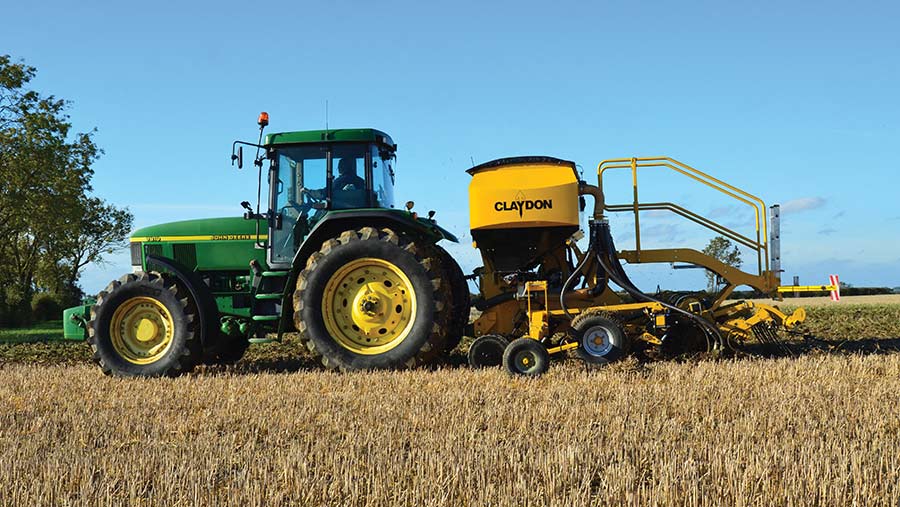Why better planning can reduce farm machinery costs
 © Claydon
© Claydon Better planning and closer scrutiny of machinery purchases were key points among the tips and advice at a recent Farmers Weekly Transition webinar on buying new kit.
The expert panel agreed that recent global, political and market turmoil had put input prices in sharp focus, and that included machinery replacement costs.
To cope, they suggested that a more rigorous approach should be adopted.
See also: Buying the right farm machinery when switching to a new system
Expert panel
Transition webinar host Hugh Broom was joined by four experts to discuss issues surrounding machinery replacement, including costs, buying regimes, planning and machinery rings.
- David Furber, sales manager at Claydon Drill
- Gary Markham, director, farms and estates, at rural accountants Land Family Business
- Mike Purnell farm manager for Whitbread Farms in Bedfordshire
- Gordon Cummings fuel and machinery director at Fram Farmers agricultural services co-operative
Cost rises
Claydon Drill sales manager David Furber explained the factors behind the rise in machinery costs over the past five years.
It has been a period of huge change, from labour market restrictions caused by political decisions and Covid-19, to soaring energy prices resulting from the war in Ukraine.
These factors pushed up every component cost, from the steel to microchips, and had disrupted supply.
Gary Markham, machinery director for accountancy Land Family Business (LFB), said the effect showed up in data on LFB’s client base.
The average cost across all of the firm’s clients had risen to £350/acre, while the worst-performing 25% of clients were now paying out more than £500/acre.
But he pointed out that the top 10% of his clients were spending just £230/acre by keeping a tighter grip on replacement costs.
Reducing costs
On Whitbread Farms in Bedfordshire, manager Mike Purnell said a switch to direct drilling and regenerative agriculture had helped to reduce machinery costs.
The cultivation kit list for the 1,000ha estate only amounts to a drill, a set of rolls and a mole plough.
All hedgecutting and straw and silage baling is carried out by contractors to keep machinery ownership to a minimum.
For the tractors, combine, sprayer and drill used in the arable operation, the key has been to balance the time the machinery is kept against the increasing risk of costly breakdowns and falling residual values.
Normally, larger pieces of equipment at Whitbread Farms are retained for eight years.
Tractors run to 8,000 hours before they are moved on.
Mike said that if he leaves replacing the combine until nine to 10 years, the residual value has dropped too far. Repairs, routine parts replacement and the breakdown risks are too high.
Fram Farmers fuel and machinery director Gordon Cummings suggested that purchasing machinery and keeping it for eight years could work out as the least-cost strategy.
The proviso was that the finance deal was favourable. At five years, it is more difficult to argue the case for outright ownership compared to hiring in machinery.
If keeping equipment for three years, it is probably more cost effective to hire, Gordon said.
From data on co-operative members, he reported that hiring over a 24-month period appeared to be the best approach.
But he said there was no single, right answer because every farm is different.
Hire agreement payments are partly based on hours, and Gordon said there was a big difference in costs for machines returned with 1,000 and those with 1,500 hours on the clock.
The decision on hiring versus ownership must also take labour availability and costs into account.
Depreciation and purchase planning
Gary said depreciation should be factored into accounts on a reducing balance basis, which offered a more representative cost than straight-line depreciation used by some accountants.
This means depreciation should be calculated at 15% a year for any machinery with an engine, and 20% a year on equipment that is trailed behind, Gary said.
He urged farmers to adopt the approach of calculating costs per acre to act as a benchmarking guide. This will indicate whether the farm is over-mechanised.
He suggested creating an eight-year spreadsheet of depreciation and running costs to set out payments and identify when to buy and sell.
Machinery sharing
Gordon suggested that when people think of sharing equipment, they think of machinery rings.
Theoretically, it seems like a wonderful idea to have machinery moving with season from the South to the North, but it doesn’t work in practice, he said.
But weather can cause timing issues on different farms.
What works better is a tighter tie-up between the businesses, he said. Participating farms operate as a single body, buying and selling inputs and grain together, so there is not a benefit for one above the other.
Gary agreed that this approach worked better than a machinery ring. He suggested that farm businesses should be joined as a syndicate limited liability partnership (LLP).
Each farm has a share in the LLP and draws a percentage share of the output according to its acreage. Working with LLPs, Gary said he had seen machinery costs cut from about £350/acre to £250/acre.
Transition webinars
Listen to this and other Transition webinars

